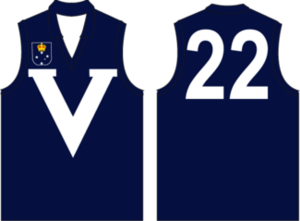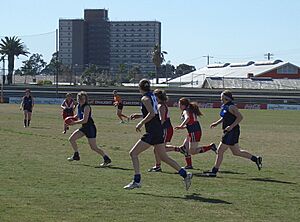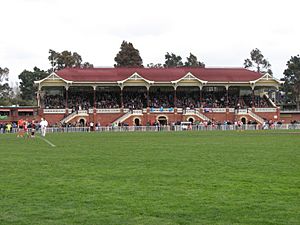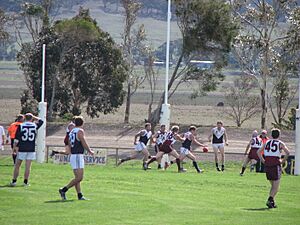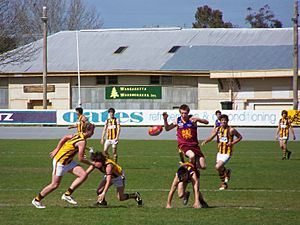Australian rules football in Victoria facts for kids
Quick facts for kids Australian rules football in Victoria |
|
|---|---|

The grand final of the Omeo & District Football League in 2001.
|
|
| Governing body | AFL Victoria |
| Representative team | Victoria |
| First played | Melbourne 31 July 1858 |
| Registered players | 235,970 (2023) |
| Clubs | 1,242 (76 competitions) |
|
Club competitions
|
|
|
Victorian Football League
Victorian Amateur Football Association Eastern Football League Northern Football Netball League Essendon District Football League Southern Football Netball League Western Region Football League Ovens & Murray Football League |
|
|
Audience records
|
|
| Single match | 121,696 (1970 VFL Grand Final) |
Australian rules football is a super popular sport in Victoria. It's the most watched and second most played type of football here. This exciting game first started in Melbourne in the late 1850s. It quickly became the biggest sport, and it still is today!
Victoria has more than twice as many players as any other state in Australia. About 42% of all Australian players were from Victoria in 2023. The sport is still growing strong! While soccer has a similar number of players, Australian rules football is a huge part of Victorian life. The sport is managed by AFL Victoria in Melbourne. The main national group, the AFL Commission, is also based in Melbourne.
The national Australian Football League (AFL) grew from the Victorian Football League (VFL). The VFL started in 1896 and became national in the 1980s. Ten out of 18 AFL clubs are still based in Victoria. These include the four oldest clubs and the most successful ones. Victorian teams have won two-thirds of all AFL championships.
Victoria is home to the Cordner–Eggleston Cup, which began in 1858. This is the longest running football competition in the world! The Melbourne Football Club is the oldest club in the sport. It wrote the first rules in 1859. It's also the oldest professional football club of any type in the world. Victoria also hosted the first official tournament, the Challenge Cup, in 1861.
The Melbourne Cricket Ground (MCG) is a famous stadium. It can hold over 100,000 people! It's known as the "spiritual home" of the game. The MCG hosts the biggest event in the sport, the AFL Grand Final, every year until 2058. This huge game is usually played on the last Saturday in September. Victoria also hosts other big matches. These include the yearly Anzac Day match, King's Birthday match, and Dreamtime at the 'G.
The Victoria Australian rules football team has won more championships than any other state. They won 16 out of 19 big tournaments until 1975. Since then, Victoria has been undefeated in State of Origin games. They won against a combined "rest of Australia" team in 2008 and 2020. Victorian teams have also won most of the National underage championships. They have won two-thirds of the titles since 1976. Victorian clubs have also won 10 out of 19 Championships of Australia.
Victoria has produced many of the greatest players in the game's history. All four Australian Football legends in the Sport Australia Hall of Fame are from Victoria. These legends are Ron Barassi, Ted Whitten, Bob Skilton, and Leigh Matthews. In 2024, most of the Australian Football Hall of Fame Legends were also from Victoria (20 out of 31). Victoria also holds the world record for attendance at a game. A massive 121,696 people watched the 1970 VFL Grand Final. This game was between Carlton and Collingwood.
Contents
How the Game Started
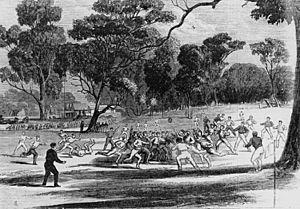
The idea for Australian rules football came from Tom Wills in Melbourne in 1858. Wills wrote a letter in a newspaper on July 10, 1858. He asked for a "foot-ball club" with "a code of laws" to help cricketers stay fit in winter. A game was played at the Richmond Paddock (now Yarra Park) on July 31, 1858. This was likely an early form of football.
The Melbourne Football Club was started on May 14, 1859. It was one of the world's first football clubs of any kind. The Melbourne Football Club rules from 1859 are the oldest rules for Australian football that we still have. These rules were written on May 17 by Wills and others. At first, clubs had to agree on rules before each match. But by 1866, many clubs agreed to play by Melbourne's updated rules.
First Organised Games
The first club competition in Australia was the Caledonian Society's Challenge Cup (1861–64). This competition made sure that only the Melbourne rules were used. This helped create a standard set of rules called "Victorian rules." In 1866, a new rule, the running bounce, became official. This rule made the game unique to Victoria.
The VFA Era

On May 17, 1877, the Victorian Football Association (VFA) was formed. This was Victoria's first main group for Australian football. Important clubs like Carlton, Melbourne, and Essendon were part of it. Many rules changed during these early years.
Football Grows Outside Melbourne
Football wasn't just played in Melbourne. Goldfield areas also saw a boom in the 1880s and 1890s. Leagues like the Sandhurst Football Association (now Bendigo) and the Ballarat Football Association started. These leagues helped older clubs outside Melbourne, like Ballarat (1860) and Sandhurst (1861), have regular games. These country clubs often helped develop players for the bigger leagues in Melbourne.
The VFL is Formed
A disagreement in the VFA led to the creation of the Victorian Football League (VFL). The VFL started playing in 1897. Eight stronger clubs left the VFA to form this new league. These clubs included Carlton, Collingwood, Essendon, and Melbourne. Essendon won the first VFL championship.
More VFA clubs joined the VFL later. Richmond joined in 1908. Footscray, Hawthorn, and North Melbourne joined in 1925. By then, the VFL had become the most important league in the game.
Becoming a National League
In 1982, a big change happened. The South Melbourne Football Club moved to Sydney and became the Sydney Swans. This showed that the sport was growing nationally.
In the late 1980s, other states became very interested in the VFL. This led to a more national competition. Two more non-Victorian clubs, the West Coast Eagles and the Brisbane Bears, started playing in 1987.
The league changed its name to the Australian Football League (AFL) after the 1989 season. Later, more teams from Western Australia and South Australia joined. The VFA/VFL became a second-tier league. Even this league has grown to include a team from Tasmania.
Some of the biggest local clubs that joined the national league still face challenges. For example, the Fitzroy Football Club had problems and merged with the Brisbane Bears to form the Brisbane Lions. The AFL helps historic clubs like Melbourne, Western Bulldogs, North Melbourne, and Carlton stay in the national competition.
Who Plays the Game?
In 2004, Victoria had 36,900 senior players. This was more than any other state in Australia. In total, 223,999 people participated in the sport in Victoria. This means about 4% of the population plays, making it one of the most popular states for the sport.
Watching the Game
Attendance Record
- 121,696 (1970). This was for the VFL Grand Final between Carlton and Collingwood at the MCG in Melbourne.
Big Australian Rules Events in Victoria
- Australian Football League Premiership Season (including special matches like the Anzac Day match, Dreamtime at the 'G, and King's Birthday match)
- AFL Grand Final (every year)
- VFL Grand Final (every year)
- International Rules Series (every two years)
- E. J. Whitten Legends Game (a charity game every year)
- Community Cup (a charity game every year)
- Multicultural Cup (a free event every year)
Famous Victorian Footballers
Many famous players in the Australian Football Hall of Fame are from Victoria. These include:
- Ron Barassi
- Haydn Bunton Sr.
- Roy Cazaly
- John Coleman
- Jack Dyer
- Bill Hutchison
- Leigh Matthews
- John Nicholls
- Bob Pratt
- Dick Reynolds
- Bob Skilton
- Ted Whitten
- Ian Stewart
- Gordon Coventry
- Kevin Bartlett
- Jock McHale
- Norm Smith
- Kevin Murray
- Tony Lockett
- Kevin Sheedy
- John Kennedy Sr.
Most of the male players in the Australian Football Hall of Fame are from Victoria.
-
Ron Barassi statue at the MCG
-
Leigh Matthews statue at MCG
-
Ted Whitten statue at Whitten Oval
-
John Kennedy Sr. statue at Waverley Park
Famous female players include Debbie Lee (the first female in the Australian Football Hall of Fame) and Daisy Pearce. Erin Phillips was born in Melbourne.
Who Runs the Sport?
The main group that manages Australian rules football in Victoria is AFL Victoria.
Leagues and Clubs
Professional Clubs

- Carlton Football Club (Australian Football League)
- Collingwood Football Club (Australian Football League)
- Essendon Football Club (Australian Football League)
- Geelong Football Club (Australian Football League)
- Hawthorn Football Club (Australian Football League)
- Melbourne Football Club (Australian Football League)
- North Melbourne Football Club (Australian Football League)
- Richmond Football Club (Australian Football League)
- St Kilda Football Club (Australian Football League)
- Western Bulldogs (formerly Footscray Football Club) (Australian Football League)
Other Leagues
Statewide Leagues
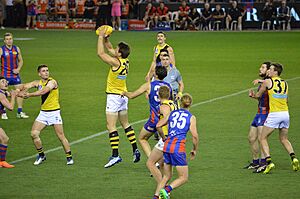
- Victorian Football League
Melbourne Leagues
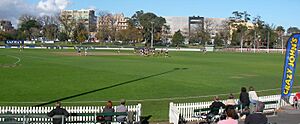
- Eastern Football League
- Essendon District Football League
- Northern Football League
- Southern Football League
- Victorian Amateur Football Association
- Western Region Football League
Regional Leagues
- Victorian Country Football League (manages football in regional Victoria)
- Ballarat Football League
- Bendigo Football League
- Geelong Football League
- Goulburn Valley Football League
- Ovens & Murray Football League
- And many more local leagues across Victoria!
Junior Leagues
- Yarra Junior Football League
- South Metro Junior Football League
- And other junior leagues for younger players.
Women's Leagues
- Victorian Women's Football League
- Youth Girls Competition
Main Football Stadiums
These are some of the biggest stadiums in Victoria where Australian rules football is played.
| Melbourne | Melbourne | Geelong |
|---|---|---|
| Melbourne Cricket Ground | Docklands Stadium | Kardinia Park |
| Capacity: 100,024 | Capacity: 55,347 | Capacity: 40,000 |
| Record: 121,696 (1970) | Record: 54,444 (2009) | Record: 49,109 (1952) |
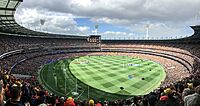 |
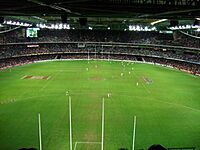 |
 |
| Wangaratta | Melbourne | Melbourne |
| Norm Minns Oval | Coburg City Oval | Princes Park |
| Capacity: 15,000 | Capacity: 15,000 | Capacity: 12,000 |
| Record: 11,000 (2013) | Record: 21,626 (1965) | Record: 62,986 (1945) |
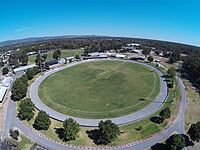 |
 |
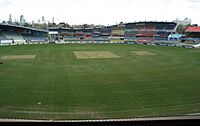 |
| Ballarat | Melbourne | Bendigo |
| Eureka Stadium | Victoria Park | Queen Elizabeth Oval |
| Capacity: 11,000 | Capacity: 10,000 | Capacity: 10,000 |
| Record: 10,412 (2022) | Record: 47,000 (1948) | Record: 16,600 (1957) |
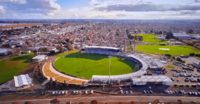 |
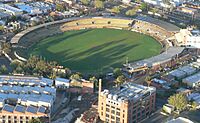 |
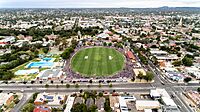 |
| Melbourne | Melbourne | Melbourne |
| Whitten Oval | Box Hill City Oval | Windy Hill |
| Capacity: 10,000 | Capacity: 10,000 | Capacity: 10,000 |
| Record: 42,354 (1955) | Record: 6,200 (1983) | Record: 43,487 (1966) |
 |
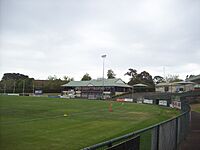 |
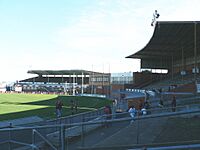 |
| Melbourne | Melbourne | Melbourne |
| Moorabbin Oval | Chirnside Park | Casey Fields |
| Capacity: 10,000 | Capacity: 9,000 | Capacity: 9,000 |
| Record: 51,370 (1965) | Record: 10,000 (1982) | Record: 10,099 (2007) |
 |
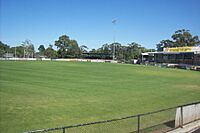 |
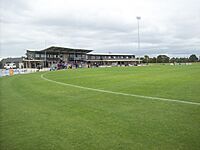 |
| Melbourne | Melbourne | Melbourne |
| Frankston Oval | Preston City Oval | Arden Street Oval |
| Capacity: 5,000 | Capacity: 5,000 | Capacity: 4,000 |
| Record: 3,722 (2023) | Record: unknown | Record: 35,116 (1949) |
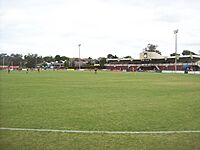 |
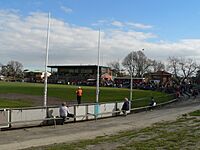 |
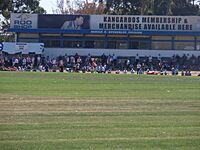 |
Other Venues
- Morwell Recreation Reserve (Morwell)
- Deakin Reserve (Shepparton)
- Punt Road Oval (Melbourne)
- Trevor Barker Beach Oval (Melbourne)
- Elsternwick Park (Melbourne)
- Williamstown Cricket Ground (Melbourne)
Old Stadiums (No Longer Used for AFL)
- Waverley Park (used from 1970-2000)
- Glenferrie Oval (former home of the Hawthorn Football Club)
- Lakeside Oval (former home of the South Melbourne Football Club)
- Junction Oval (now mainly used for cricket)
Victoria's Representative Team
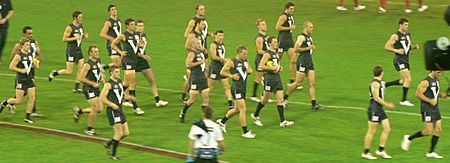
Victoria's representative team is called the Big V. They play State of Origin matches against teams from other Australian states. Since 1999, the main professional team has only played once, in the 2008 AFL Hall of Fame Tribute Match.
See Also
- Interstate matches in Australian rules football


